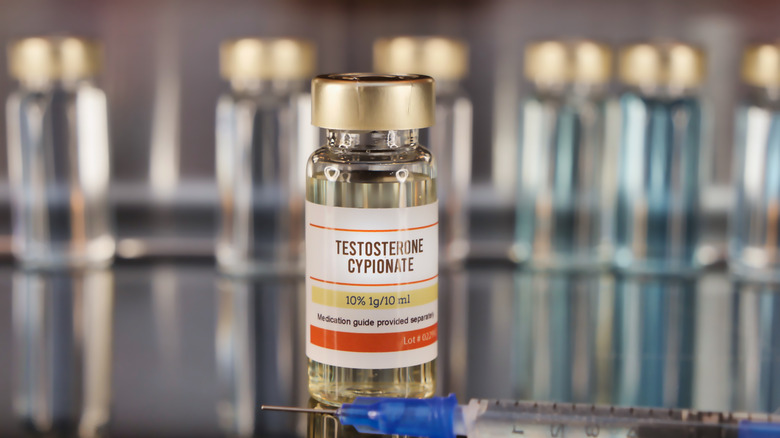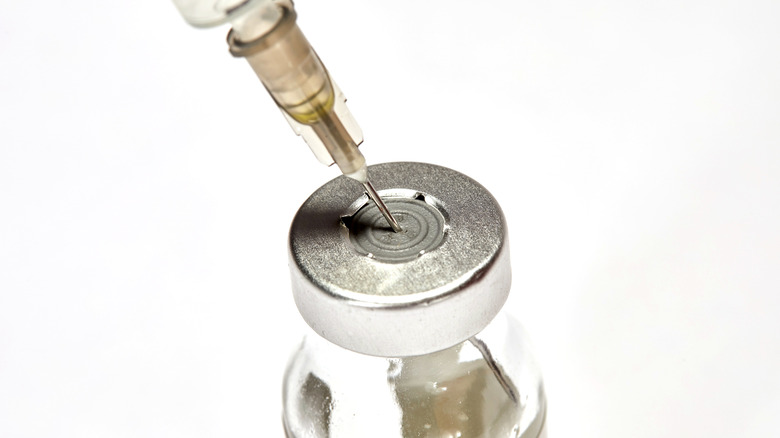Everything You Should Know About Hormone Therapy For Trans Men
When babies are born, their are typically assigned a gender that matches their genitalia. However, as Gender Spectrum explains, sex and gender are different, and for some people, their gender doesn't match their genitalia or their gender assigned at birth. Gender is a complex self-concept determined by a person's internal experience, how they present socially, and their experience of their body.
According to National LGBT Health Education Center, a person who has a different gender identity than the gender they were assigned at birth is a transgender person, though not everyone chooses to use that label. Transgender is a broad term that also includes people whose gender identity doesn't fall into the gender binary — in other words, people whose gender identity isn't male or female.
Some people who were assigned female at birth don't align with that gender assignment and identify themselves as trans men or, simply, men. Sometimes they identify themselves as "female to male," which is often abbreviated to FTM. Many trans men choose to change the way they present themselves to the world so that their appearance and mannerisms reflect their gender identity. They may choose to change the way they dress, act in ways that are traditionally deemed masculine, and stop acting in ways that are traditionally deemed feminine. Many trans men also choose to change their bodies to match their gender identity. They typically do this through hormone therapy and gender affirming surgeries.
How does someone know if they're a trans man?
According to the Mayo Clinic, children can identify gender labels and gender roles as early as 18 to 24 months. By five they have a rigid understanding of gender and gender roles. Some children as young as three or four may understand that their gender doesn't match their assigned gender and display this by rejecting behaviors typical to their assigned gender. For example, a child assigned female at birth may insist on standing instead of sitting while potty training. Though rejecting gendered behavior doesn't necessarily mean a child is transgender, it can be an sign.
Many children learn to suppress their gender identities in order to fit in. Many trans men say that they felt "different" from other girls their whole lives but couldn't understand why, as one man told Cosmopolitan. However, many trans men don't understand their gender identity until adulthood. In an essay for Them, Kasey LeBlanc described how many trans men don't know they're trans because they didn't experience the feeling of "being born in the wrong body." As Gender Spectrum points out, many people aren't given the language to properly describe their gender until adulthood. So, they may not identify that their discomfort with their gender assigned at birth or their bodies stems from being trans. Trans men come to understand that they're trans in myriad ways. The single common experience is that they realize they're not female.
What does it mean to medically transition?
Once trans men realize that their gender identity doesn't match their gender assigned at birth, they may decide that they want to change the way they present their gender. This is called transitioning.
According to the University of San Francisco's Transgender Care program, one of the leading authorities on gender-affirming care, there are two kinds of transition processes: social transition and medical transition. Social transition refers to the ways that a trans man decides to present themselves to others. It often, but not always, includes changing the way they dress, wearing a binder to appear more flat-chested, packing (wearing a penile prosthesis to mimic having a penis), changing their pronouns, and changing their name. Medical transition refers to the medical treatments trans people undergo to change their bodies to match their gender identity.
For trans men, medical transition can include a variety of treatments. The most common treatments for trans men, per Planned Parenthood, include taking testosterone hormone therapy, surgery to remove the breast tissue to construct a masculine chest (top surgery), hysterectomy, surgery to construct a penis (phalloplasty), and surgery to make the clitoris function as a penis (metoidioplasty).
Why some trans men choose to medically transition
Trans men often experience a psychological condition called gender dysphoria. The National Institutes of Health (NIH) states that the fifth edition of the Diagnostic and Statistical Manual of Mental disorders (DSM-5) defines gender dysphoria as "marked incongruence between their experienced or expressed gender and the one they were assigned at birth." People struggling with gender dysphoria experience extreme psychological distress because their assigned and perceived gender doesn't match their gender identity.
Many people with gender dysphoria have a strong desire to change their bodies because their bodies don't align with their gender identity. Trans men who experience gender dysphoria may want to change their bodies so they have masculine characteristics. This is the purpose of medically transitioning.
Research has shown that medically transitioning has a significant impact on the mental health of trans people. An analysis of existing research performed by Cornell University found that medical transition with hormone therapy and/or gender-affirming surgeries "is effective in treating gender dysphoria and can significantly improve the well-being of transgender individuals." Cornell's analysis revealed that people who medically transitioned experienced "improved quality of life, greater relationship satisfaction, higher self-esteem and confidence, and reductions in anxiety, depression, suicidality, and substance use."
Do all trans men choose to medically transition?
Though many trans men choose to take testosterone and/or undergo gender affirming surgeries, not all trans men choose to medically transition. According to a Vox feature on myths about trans folks, there are myriad reasons why trans men may decide not to medically transition. Some can't afford the hormones or the surgeries, others have medical conditions that prevent them from taking hormones or having surgery, and others just don't want to take hormones or have surgeries.
A BuzzFeed survey of trans folks who'd decided not to medically transition revealed that the pervasive narrative that trans people feel like they're "born with the wrong parts, or in the wrong body," as one person put it, doesn't apply to every trans person. For some trans men, social transition is much more important than medical transition. Some just don't feel that changing their bodies is a necessary part of confirming their gender.
All of the trans folks who responded to the survey stressed that trans people who choose not to medically transition are just as valid as trans folks who take hormones and/or get surgeries. As The Trevor Project explains, gender identity is about "your own personal sense of what your gender is." So, if someone feels like their gender doesn't match the one they were assigned at birth, they're trans, regardless of whether they change their body to conform with the physical expectations of their gender.
How hormone therapy for trans men is administered
Trans men who decide that they do want to medically transition may choose to take testosterone. A paper in the Translational Andrology and Urology medical journal explains that trans men take testosterone to bring their levels into the male range and suppress the production of female hormones. Injection — either subcutaneous or intramuscular — and topical gel are the most common ways that trans men self-administer testosterone.
Those who choose to give themselves a shot of testosterone on a weekly or biweekly basis are taught how to perform the injections by their healthcare provider. Planned Parenthood states that subcutaneous shots should be done in the stomach, while intramuscular shots should be done in the thigh. The doctor prescribing the testosterone will decide which type of injection works best. Testosterone gel typically comes in a pump bottle or in individual packets by dosage, per Folx Health. The gel is applied like lotion to the shoulders, thighs, or stomach, usually once per day.
Testosterone can be administered in several different doses, and people often start at a smaller dose and work their way up (via Translational Andrology and Urology). A healthcare provider needs to make dosage decisions based on the patient's medical history and physical transition goals. They also need to closely monitor the physical, mental, and emotional changes that come with taking testosterone (via Folx Health). So, it's essential that trans men work with a qualified provider.
Physical and emotional changes that may happen after starting testosterone
Every trans man experiences slightly different physical changes from taking testosterone. Per the Cleveland Clinic, the physical changes are largely determined by age and genetics. So, it's hard to predict exactly which physical changes will occur, how noticeable these changes will be, and how long it will take for changes to occur.
That being said, the majority of trans men will experience some level of change to their skin, body composition, menstrual cycles, hair growth, voice, and genitals. Often, oily skin and acne are the first changes that trans men notice. This can happen as soon as a month after starting testosterone. Between three months and six months after starting testosterone, trans men may start to see an increase in body hair, a redistribution of their body fat to a more masculine pattern, and maybe even some facial hair. Their voice will start to drop as well. Many trans men also experience changes to their clitoris and vagina during this time period. The clitoris gets bigger, the vaginal tissue may start to atrophy, and the menstrual cycle starts to change. Around six months, many trans men notice increased muscle mass and strength.
Many trans men also experience emotional changes after a few months on testosterone. According to Plume, trans men often notice increased irritability, mood swings, and different emotional reactions. However, most also experience improved self-esteem and less gender dysphoria.
Which physical changes are permanent and which ones aren't?
While some of the physical changes that occur because of taking testosterone are permanent, some of them will only persist while a person is actively taking testosterone. The University of San Francisco's Transgender Care program states that facial hair, clitoral growth, voice deepening, and the development of male pattern baldness are permanent changes that won't be impacted by stopping testosterone. However, body fat redistribution, changes to the menstrual cycle, changes to the skin, and changes in muscle mass and strength are all dependent on actively taking testosterone. If trans men decide to stop taking testosterone for whatever reason, their bodies will slowly change.
For some trans men, the fact that many of the physical changes aren't permanent is comforting. This allows them to see whether they like the changes testosterone brings with the knowledge that they can stop any time without too many long term effects, as one trans man told Insider.
However, some trans men may want to limit certain permanent physical changes, for various reasons. Some opt to use additional medications to prevent some of the permanent changes, particularly facial hair growth and clitoral growth. A paper published in the Journal of Clinical Medicine suggests using a DHT blocker like finasteride alongside testosterone to suppress the growth of the clitoris and facial hair. Though trans men cannot pick and choose which physical changes they get from taking testosterone, because this is largely determined by genetics, medications like finasteride can provide some level of control over physical changes.
Testosterone and the menstrual cycle
As with the physical changes caused by testosterone, changes to the menstrual cycle are highly individual. One retrospective review study published in the medical journal Transgender Health found that some trans men stopped getting their periods shortly after their very first dose of testosterone, even at a lower dose of 40 mg per week. About half of the trans men participating in this study on this dosage stopped getting their periods within six months. The majority of the rest of the participants stopped getting their periods when their dose of testosterone was increased. However, the study also found that 7% of the trans men in the study didn't stop getting their periods, even on a dose as high as 60 mg per week.
Another study published in the International Journal of Transgender Health found that nearly 18% of participants had persistent menstrual bleeding three months after starting testosterone, but that all of the participants had stopped getting their periods by 18 months on testosterone. This study suggests that testosterone therapy will eventually stop the menstrual cycle for all trans men, but it may take much longer for some than others. However, further research is still needed.
Most trans men taking a low to moderate dose of testosterone will stop getting their periods within three to six months (via Transgender Health). However, some trans men will continue to get their periods for quite some time, and adjusting the dosage of testosterone will likely lead to the cessation of menstruation.
It's possible for trans men get pregnant while taking testosterone
Though testosterone will stop the menstrual cycle for the vast majority of trans men, that doesn't mean trans men can't get pregnant while taking testosterone, as OB/GYN Dr. Juno Obedin-Maliver wrote in Bedsider. You're probably thinking, "how can someone get pregnant when they don't even have their period?" Dr. Obedin-Maliver explains that ovulation – the release of an egg that's ready to be fertilized — isn't the same thing as getting a period. So, some people still release an egg every month, even if they're not getting their period. If a trans man is sexually active with someone with a penis, the egg can be fertilized and result in a viable pregnancy.
The UK's National Health Service (NHS) states that trans men who do get pregnant and want to give birth will need to stop using testosterone for the duration of the pregnancy because an excess of testosterone can harm the developing fetus. To prevent pregnancy, trans men should take birth control in addition to testosterone, under the close supervision of a medical provider.
Some trans men may decide that they do want to get pregnant at some point, and research has shown that this is often possible. As NBC News recently reported, there has long been an assumption that long-term testosterone therapy would prevent trans men from getting pregnant even after they discontinued testosterone use. However, new research — and the experiences of trans men themselves — has shown that successful pregnancy is possible for trans men, even if they've been on testosterone for a long time.
Risks of taking testosterone
Though testosterone therapy is generally considered safe, there are some risks. According to the Mayo Clinic, trans men taking testosterone have a higher risk for high cholesterol, high blood pressure, and type-2 diabetes. Regular blood tests should be performed to check the cholesterol and glucose levels. Blood pressure should be regularly monitored at routine appointments.
Some trans men undergoing testosterone therapy also develop a condition called polycythemia. This means that the body is producing too many red blood cells, which the Mayo Clinic states can lead to life-threatening blood clots. This potential side effect also means that trans men have an increased risk for pulmonary embolisms and deep vein thrombosis. The red blood cell counts of trans men taking testosterone also need to be closely monitored to catch this condition early if it occurs.
Some relatively common side effects of testosterone therapy include acne, weight gain, and the development of male-pattern baldness. These side effects are a normal part of the masculinization process, however, some trans men struggle with them. So, it's important to know these side effects can happen. The changes to the genitals that typically occur during testosterone therapy can also cause discomfort. The enlargement of the clitoris can be painful for some trans men, and some experience thinning and drying of the skin in the vagina, called vaginal atrophy.
How can trans men access testosterone?
The vast majority of providers who prescribe testosterone therapy follow the standards of care outlined by the World Professional Association for Transgender Health (WPATH). The organization suggests that people seeking hormone therapy for the purpose of medical transition should have a documented history of gender dysphoria, should be capable of making sound decisions about their own body, should meet the age requirements outlined by the state in which they live, and that any mental health issues should be well-managed. WPATH also emphasizes informed consent, which means that the person seeking hormone therapy should be completely aware of the intended effects, the side effects, and the risks. Many providers require a thorough process before hormones can be prescribed. Additionally, many insurance companies have their own requirements for covering testosterone therapy.
There are several avenues for accessing testosterone. Some people choose to go through their primary care provider or a specialist they already see. Others might seek care at their local Planned Parenthood, though trans care isn't available at Planned Parenthood locations in certain states.
People who don't want to go through a doctor they already see or are having trouble accessing hormone therapy can turn to online services like Plume and Folx Health. People pay these services a monthly subscription fee, which gives them access to appointments with qualified medical professionals via virtual appointments. These providers prescribes testosterone, which is shipped to the patient. These services aren't available in every state, however.
Age requirements for starting testosterone
Providing hormone therapy to trans men under 18 years old is a controversial topic, as pointed out by the Associated Press. Some medical professionals argue that many teens are simply questioning their gender identity and aren't ready to make the decision to transition. Erica Anderson, a psychologist who used to be a board member of the WPATH, told the Associated Press that doctors aren't doing enough to screen teens before offering them hormone therapy, which can have irreversible results.
However, many other medical professionals believe that the earlier teens have access to hormone therapy, the less time they have to suffer the debilitating effects of gender dysphoria. Pediatrician Dr. Michelle Telfer told Buzzfeed News that teens struggling with gender dysphoria are at high risk for self-harm, suicide attempts, and suicide. She argues that access to hormone therapy is life-saving for trans teens, and many agree with her.
In the United States, different states have different age requirements for beginning hormone therapy. According to The American College of Obstetricians and Gynecologists, most places require parental permission for teens under 18. Some forms of hormone therapy can only be started after age 16, but some places allow teens to take medications that block puberty before age 16. In 2022, WPATH officially lowered its age recommendations for hormone therapy, stating that teens as young as 14 could start hormone therapy as long as they'd undergone proper screening (via Associated Press). However, teens frequently still have trouble accessing hormone treatment, as The Conversation explored.
If you or anyone you know is having suicidal thoughts, please call the National Suicide Prevention Lifeline by dialing 988 or by calling 1-800-273-TALK (8255).
Do trans men have to take testosterone forever?
Trans men who decide to take testosterone don't have to take the hormone for the rest of their lives, though some choose to do so. However, if trans men stop taking testosterone, their bodies will start to change again, per the Vancouver Coastal Health transgender health program.
Insider interviewed trans men and non-binary folks about their experiences stopping testosterone, and they revealed that many people choose to stop hormone therapy for myriad reasons. Some people decide to take testosterone for a short period of time until their voice deepens and they grow facial hair – two of the effects that don't change when you stop testosterone. Since these were the only changes they wanted, they stopped testosterone as soon as they got them. Others stop taking testosterone temporarily to adjust to their bodies as they change. Still others start taking testosterone, find that it doesn't feel right for them, stop taking it altogether, and focus on social transition. Trans men who want to take testosterone aren't stuck in their decision. They can, and often do, change their minds.
What happens if trans men stop taking testosterone?
According to the Vancouver Coastal Health transgender health program, if trans men stop taking testosterone, their body fat will redistribute to a more feminine pattern and they'll lose the muscle tone and strength they gained from taking testosterone. Their menstrual cycles will resume as well.
Some trans men who stop taking testosterone also lose some of the facial hair they grew; however, it will not disappear completely. Additionally, stopping testosterone can cause the clitoris to shrink if it got bigger as a result of testosterone therapy. However, this doesn't happen for everyone who stops taking testosterone. Some people find that clitoral growth is one of the irreversible effects of testosterone therapy.
According to the University of San Francisco's Transgender Care program, the changes people experience when they stop taking testosterone largely depend on how long they were taking testosterone and what dose they were taking.















